Features (articles)
Japanese Cooking 101: Final thoughts, or what was the point?
I'm still getting reactions to the recently completed Japanese Cooking 101 course (if you missed it, here's the complete list of lessons.) While the reactions have been overwhelming positive, I've gotten a couple of negative comments too.
One I wanted to address in particular is the accusation, if you will, is that the lessons do not represent that way most people cook in Japan anymore. One person even opined that I was not a 'real Japanese' because I didn't cook like 'the Japanese people I know in Tokyo' or something like that.
Well you know what, that person is right about one thing: Many (not all!) people in Japan don't take the time to make their own dashi from scratch, or grow their own shiso or other herbs. Some rely on prewashed rice called musenmai (無洗米) so they don't have to bother with rinsing rice either. A lot of recipes on various Japanese cooking sites call for the use of mentsuyu (めんつゆ), bottled noodle sauce concentrate, a ready-made combination of soy sauce, mirin, sugar, and dashi. It saves time having to pull out each individual ingredient and adding it one by one, for sure. There are just as many convenience foods and ready-made foods in Japan as there are anywhere else - not to mention tons of restaurants, fast food places, and the like. You can easily avoid having to cook, ever. And sadly, a lot of people are like that. Japan is after all one of those so-called developed countries, where conveniences abound.
I have plenty of quick and easy recipes on JustHungry, and many more on JustBento - although I do try to stick as much as possible to real ingredients. (Some of my Japanese recipes call for the use of dashi stock granules, especially when they're used as an underlying flavor rather than the main flavor. They're so convenient, plus I've heard from many readers that they're easier to get a hold of than bonito flakes and konbu seaweed.)
HOWEVER!

The whole point of the Japanese Cooking 101 course was to show how things are done for the best possible results, using traditional methods.
Most of the readers of my sites do not live in Japan. I'm not writing for a Japanese audience obviously, since I'm writing in English. I'm not even writing for an audience of English speaking residents of Japan - although I know there are some who've been following along for years (hi guys!). (My column in The Japan Times on the other hand is aimed at English speakers in Japan, so has a rather different focus.) Unless you live in a city with proper Japanese groceries, it can be very hard to get a hold of the right ingredients. Things like mentsuyu are often too expensive to rely on all the time.
Let's face it, most Japanese ingredients are expensive outside of Japan, if you can even get a hold of them. If you're going to try to make proper tasting Japanese food under those circumstances, I would much rather you spend your precious money on basic, fundamental, real ingredients rather than manufactured convenience products. If you have access to a Japanese grocery store you can get things like mentsuyu, or the Japanese equivalents of Hamburger Helper and the like. But they're expensive - too expensive for everday use. On the other hand, although soy sauce, mirin, sake, konbu seaweed and bonito flakes to make dashi, plain old miso and so on are not cheap either, they're a much better investment of your money if you want to create many authentic tasting dishes.
The point is, I want to be able to teach a little bit about how to cook Japanese food the proper way, through my sites, my book and my other writings. Cooking from scratch is, in my opinion, a fundamental skill, and I'm fighting the battle to keep that skill alive. Even if that notion is laughably old fashioned for some people.
Filed under: philosophy washoku japanesecooking101Food packaging labeling for allergy-causing substances in Japan
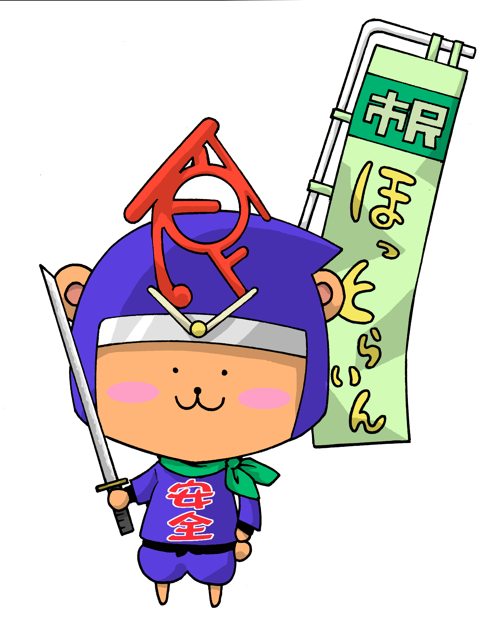
Last year I uploaded a series of printable cards for communicating dietary restrictions in Japan. This is a follow-up of sorts to this, with some information about food package labelling and allergy-causing products.
There are 7 substances that must, by law, be indicated as being present on packaged foods that contain them in Japan. I've listed them below in this order: English: kanji: hiragana or katakana: roma-ji.
- Eggs : 卵 : たまご : tamago
- Dairy : 乳 : にゅう : nyuu (For dairy products, look for that character 乳 since it's usually used together with other kanji, e.g.乳製品 for 'dairy products'.
- Wheat : 小麦 : こむぎ : komugi. Again look for the 小麦 part. Wheat flour for instance is 小麦粉.
- Shrimp : 海老 : えび (sometimes エビ) : ebi
- Crab : 蟹 : かに or カニ : kani
- Soba (buckwheat) : 蕎麦 : そば : soba
- Peanuts : 落花生 : らっかせい : rakkasei. Also called peanuts - ピーナッツ
Then there are 18 other food substances that are recommended to be indicated if they're present.
- Abalone : 鮑 : あわび : awabi
- Squid : (the kanji is rarely used) : いか or イカ : ika
- Oranges : (no kanji since it's a loan word - see notes) : オレンジ : orenji
- Kiwi : (no kanji since it's a loan word) : キウイ : kiwi
- Beef : 牛肉 : ぎゅうにく : gyuuniku
- Walnuts : 胡桃 : くるみ or クルミ : kurumi
- Salmon : 鮭 : さけ or しゃけ or じゃけ : sake or shake (pronounced sha-keh) or jake (ja-keh)
- Mackerel : 鯖 : さば : saba
- Salmon roe or salmon caviar : (no kanji since it's a loan word) : いくら or イクラ : ikura
- Soybeans : 大豆 : だいず : daizu
- Chicken : 鶏肉 : とりにく : toriniku. (Also called chicken - チキン)
- Banana : (no kanji since it's a loan word) : バナナ : banana
- Pork : 豚肉 : ぶたにく : butaniku
- Matsutake mushrooms : 松茸 : まつたけ : matsutake
- Peaches : 桃 : もも : momo
- Yamaimo (a type of yam) : 山芋 : やまいも : yamaimo
- Apples : 林檎 : りんご or リンゴ : ringo
- Gelatin : (no kanji since it's a loan word) : ゼラチン : zerachin
About oranges - I do wonder if it includes satsuma and clementines and mandarins and such, which are called oranges in the west but are called 蜜柑 - mikan - in Japan. I guess logically it should. Anyway, if you are allergic to oranges including the 'mikan' kind watch out for the オレンジ label.
Here are two examples of allergy-food labels. This one just shows the 7 must-show substances, with a black dot under the ones that are in the food. (Remember that Japanese can be written horizontally left to right or vertically.)
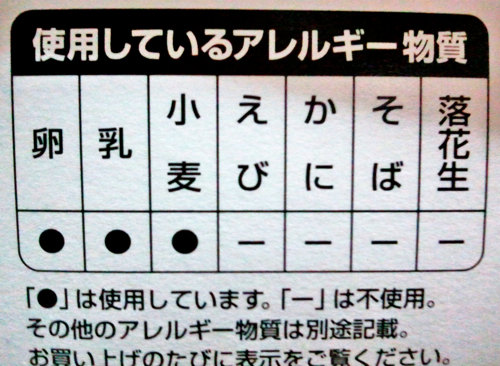
The one below shows all 25 substances in a grid, with the ones that are in the product indicated in black. I think this one makes more sense and would like to see it standardized.
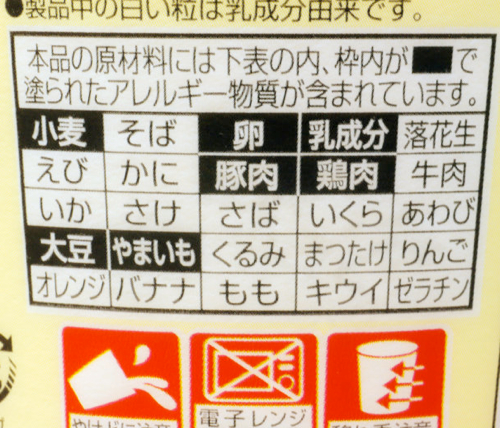
The point is to always look for the words that indicate whatever you are allergic to, even if your personal Kryptonite is not included in the substances listed above. And when in doubt, pull out one of your allergy-communicator cards and ask someone. Just pointing to a package, then showing your card, and saying, "OK?" with a helpless look on your face will be enough, I promise. Many people in Japan are quite happy with helping hapless visitors.
If you can read Japanese, there's an informative PDF on the Japanese government's Consumer Affairs Agency (消費者庁) site about allergy-causing food labeling: link to PDF.
See also: my related Quora answer here for a couple more labels.
The cute samurai warrior cat(?) character up top is the mascot of a non-profit food safety consumer hotline (Japanese only I'm afraid). Of course they have a cute mascot - it's Japan, what do you expect? ^_^
Filed under: japanese japan allergies packagingJapanese Cooking 101: Lesson 5 theme and ingredients revised to - Fish!
I have been re-thinking the last cooking lesson for Japanese Cooking 101. Originally I was going to do a mixed fish and meat lesson, but I think I will concentrate on fish since I really haven't covered fish cooking much over the years on Just Hungry. The problem I've always run into is that the availability of fish is very spotty around the world, so I'm never sure if the readers of the site can get their hands on the fish I'm talking about.
But the truth is, fish is central to washoku or traditional Japanese cooking. It's a bit hard to be a vegetarian in Japan, but being a pescatarian is very easy. While modern Japanese people do eat a lot of meat dishes, up until about 150 years ago eating meat was actively discouraged by the government, so meals were centered on vegetable proteins like tofu, and fish. And in Japan the array of fish available is rather bewildering.
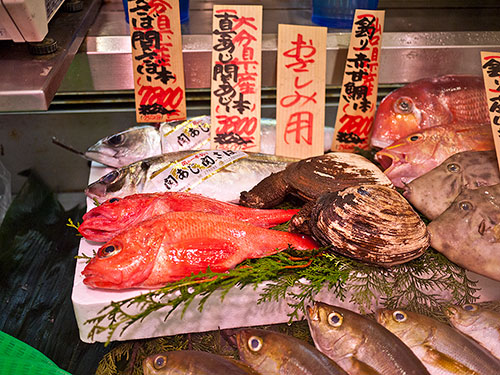
So in the spirit of showing you the real fundamentals of traditional Japanese cooking, for Lesson 5 we'll be tackling fish! If you can get a hold of the fish in question please do try following along. If not, I hope the information will be interesting at least.
Note that I'm able to get all of these fish in my small village in southern France because we have an excellent fishmonger (poissonnerie) even though we're about a 2 hour drive away from the nearest fishing port. So please take a look around to see if you have a good fish seller in your town. A good fish shop should not smell 'fishy' at all; it should smell like the fresh sea air, and be impeccably clean, with lots of shiny, bright and clear-eyed fish.
The fish to get if you can
I've arranged these in order from "probably easy to get for most people" to "maybe be very hard to get".
- A precut piece (filet) of salmon - preferably with the skin on. (this is what I listed originally previously. I'll show you a chicken variation for what I'm going to do with the salmon too.)
- Fresh,whole sardines (have the fishmonger remove the heads if you're squeamish about fish eyes)
- A flat white fish like haddock or plaice or sole (again, have the head removed if you want, but don't have the fishmonger filet the fish)
And, this last one might be very hard to get:
- a whole piece of tuna or bonito - a section of the body part, not the whole fish obviously (that would be rather unwieldly). I will show you how to break down a piece of fish to turn into pieces cut for sashimi or sushi. That's right, you don't have to restrict yourself to pre-trimmed, expensive pieces of sashimi-fish from Japanese grocery stores or expensive fishmongers to make sashimi and sushi, as long as you have good fresh fish.
I do not expect you to get all the fish by any means, but perhaps you can file the lessons away for later.
Since I've revised the lesson plans, I'll be posting the first part early next week. (I'll be posting some non-lesson stuff in the meantime though.) I hope you'll enjoy the fish lessons!
Filed under: ingredients fish japanesecooking101
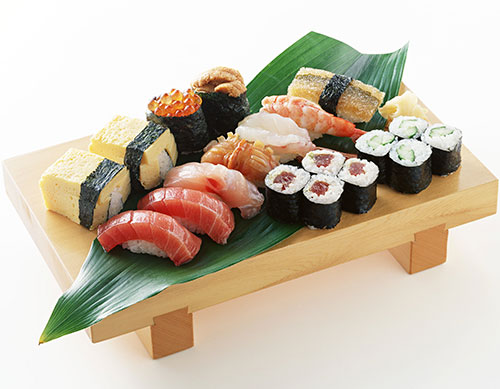
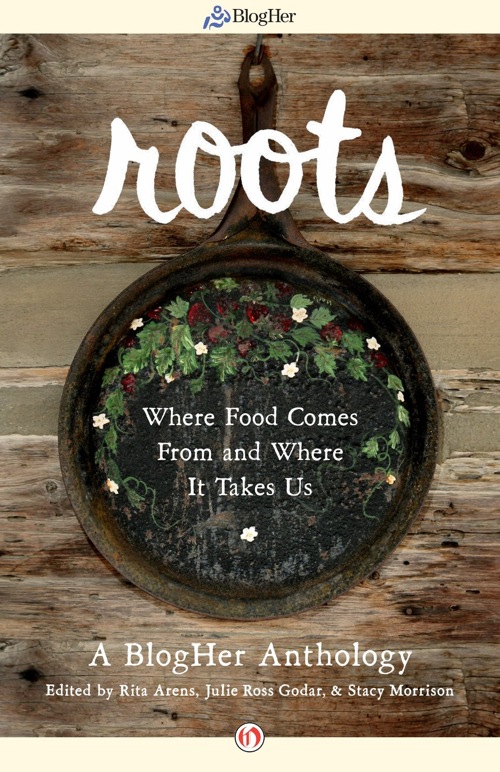


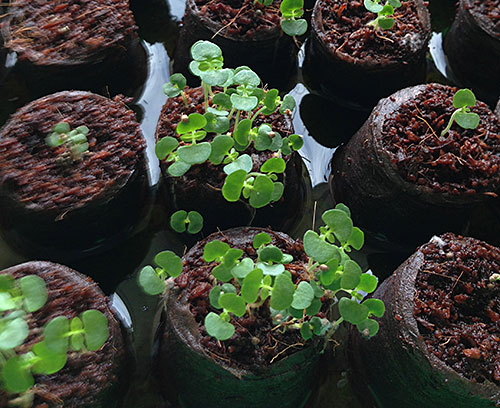
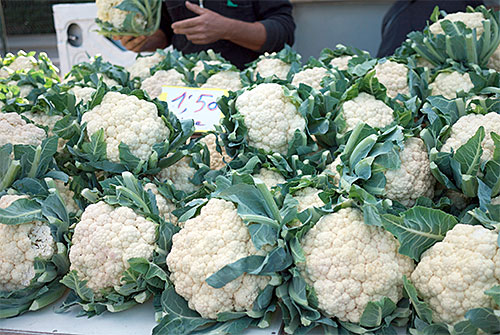
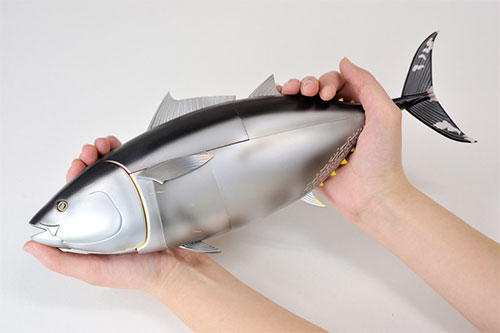
 Welcome to Just Hungry, where we serve authentic Japanese recipes and more! I'm
Welcome to Just Hungry, where we serve authentic Japanese recipes and more! I'm 













